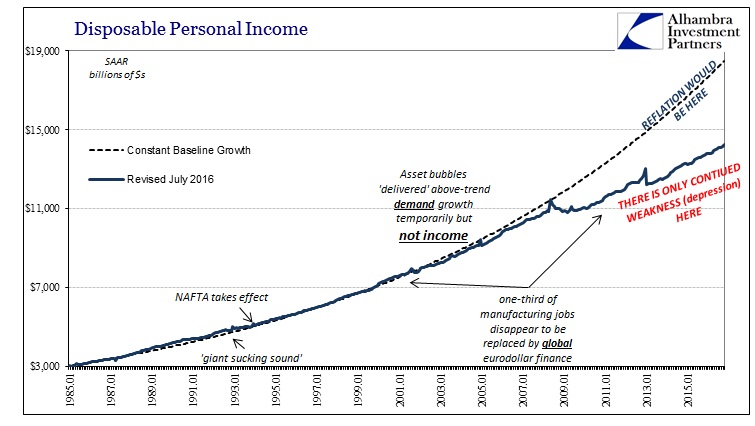Nominal personal spending grew by just over 4% in October 2016, a number that sounds impressive by virtue of what we have become used to in this economy. That was much less than the 5.2% in spending growth from the middle of 2014 just prior to the effects of the “rising dollar”, which was itself a low point for a peak period.
Between 2004 and the middle of 2006, nominal PCE averaged about 6.5%, with 7.2% recorded as a high growth rate in July 2005. And those peak “cycle” levels during the housing bubble were below the late 1990’s, where in March 2000, the month before the dot-com bubble burst, nominal PCE was 9% more than March 1999.
Adjusting for calculated inflation does nothing to alter this view of declining economic activity. In “real” terms, PCE spending was estimated to have grown 2.77% year-over-year in October, about the same as August 2007 or March 2001, both of which were at the onset of recession. Consumers appear to be stuck in an extremely weak state, but because that has become normal the way in which the various changes from low to really low and back again are interpreted and analyzed overstate the significance of that variability.

Real spending in the year 2000 averaged 5.08%, almost double the current level and that was with the dot-coms starting to collapse and recession closing in. The economy of 2016 feels very much like that difference (which is why Donald Trump will be President in January). When we hear in the media as today talking or writing about the “strong” economy of the unemployment rate, it is an error (or lie) of omission.
It is from this perspective that we also analyze the economy of 2016 as compared to 2015. Even in the narrowest of perspective, this year was supposed to be meaningfully better than last year. Whether it is income or spending, however, we find very little difference. That’s a troubling result in both ways; because of the poor economy post-Great “Recession” but also because 2015 was a particularly bad year among only bad years.
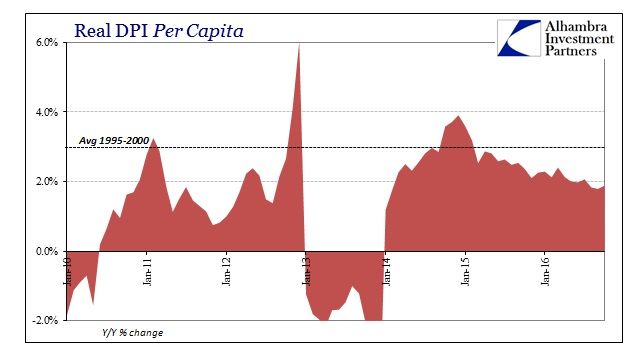
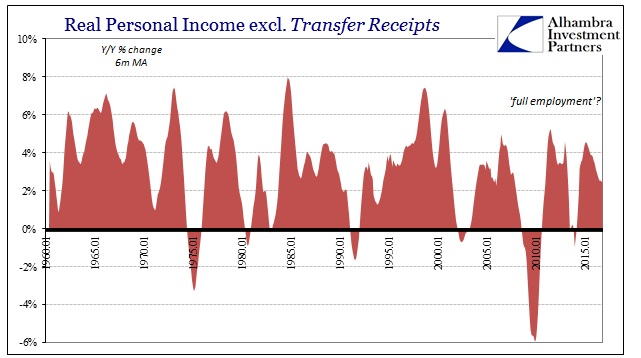
We have to tentatively address the savings rate, but with a good deal of wariness due to the constant revisions that have made the statistic highly unreliable. But for what it says now, recognizing fully that might not be what it says at some point in the future, consumers have continued to be reluctant to spend in 2016 even more than 2015. The savings rate between November 2014 and January 2016 rose from 5.5% to 6.2%. As “global turmoil” has faded as this year moved on, the savings rate has only come back by a small amount. The current estimate for October is still 6.0%.
From that, we can infer that consumers had a much different perspective of “transitory” weakness as well as the proclaimed comfort and support of the “best jobs market in decades.” It is very difficult, if not impossible, to reconcile where the labor market is supposedly robust, as given by the unemployment rate that dropped to and through the full employment area, and where spending remains at levels consistent with prior recessions and pre-recessions. The savings rate confirms the latter point of view of a more cautious consumer and persistently weak economy, rather than the BLS point of view of growing success.

That would all suggest that the economy in 2016 is very much the same as 2015, which would hardly be the jumping off point for “reflation.” Some of the current almost euphoria in and about the bond market (UST and TIPS) “inflection” is surely related to what some people expect will happen under “different”, whether Trump, someone not named Yellen, or the BoJ, PBOC, and ECB getting something right for once. For those, the current economy will not matter because that is simply the old, and old is, they claim, no longer relevant to “different.”
The reflation trade itself, however, started without so much blank future confidence and more so on the belief that since the “global turmoil” of January/February has passed, so, too, has all the negative economic fuss. For this point of view, the rise in inflation rates predates “different” such that the economy might be improving already by virtue of having experienced a near-miss with recession to start this year. If there is to be no recession, then growth is all but assured under the binary business cycle model.
The PCE Deflator has given this view only partly what it wants. Inflation rates, including the CPI, have crept back up and away from near zero. That is being taken as a sign of improvement, especially at the FOMC where being wrong about inflation has been the one true constant.

At 1.41% in October, the year-over-year change in the PCE Deflator was the highest inflation rate since late 2014. But it does not suggest anything more than oil prices, which is a significant problem. As noted with the CPI, the recent upturn is due almost entirely to the base effects of oil now being compared this year to oil last year at its lowest points. If we were to see actual economic growth in addition to these oil effects, the PCE Deflator would behave as it had in the past in similar episodes.
In the middle of 2006, for example, oil prices fell sharply in response to the initial stages of what would become the housing bust. Calculated inflation of both the CPI and PCE Deflator fell sharply, stayed low for about a year, and then sharply rebounded once past those base effects. That is what you would expect to find of actual economic/money growth setting the course for consumer prices. In 2016, by contrast, there is only subdued oil.
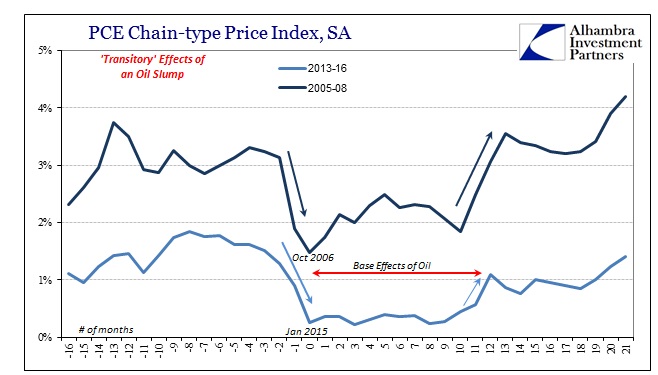
Similarly, during the Asian flu of 1997-98, oil prices dropped sharply, pulling calculated inflation rates down with them. Once that was over, inflation rates soon resumed not just their prior levels of changes but also exhibited acceleration consistent with the economy of that time.
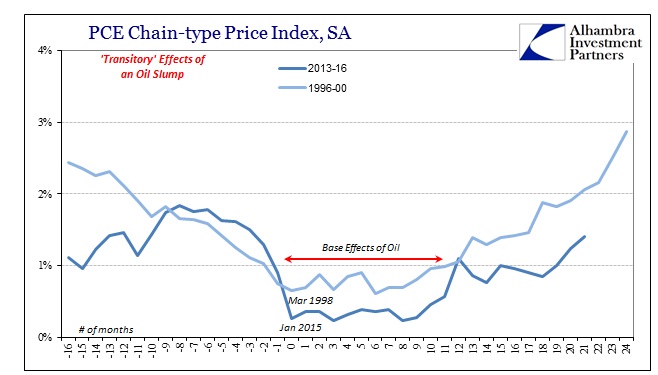
That is why analyzing the inflation rate on a 2-year change is helpful for illustrating the lackluster nature of this “improvement.” The Asian flu period shows up as a clear but clearly temporary pause for the PCE Deflator, while the 2006 oil price drop doesn’t register at all.
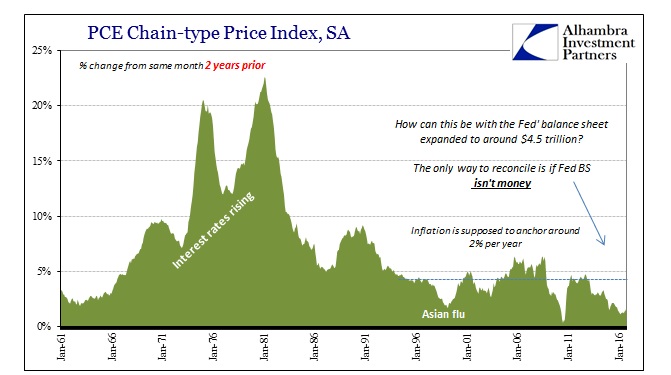
The 2-year change for the PCE Deflator in 2016, by contrast, is consistent with the trend that has been in place since the 2012 slowdown, meaning almost five years and still counting. It is the same economic trend that, despite four QE’s and a $4.5 trillion Federal Reserve balance sheet, sees only lackluster income and spending at levels consistent with past recession. Therefore, the possibility that the US economy may have narrowly missed recession to start this year is irrelevant, as there is no basis to suggest growth will necessarily follow from it.
From income to spending to inflation, recession or not recession are descriptions that don’t apply to this economy. Reflation as the economy currently stands does not appear likely or even consistent with anything other than the fact that right now oil prices aren’t falling again. That isn’t anywhere close to an actual growth stage meaningfully different from the past five years.
For those who are projecting reflation as an entirely different paradigm of solutions and fixes, they would still have to answer for this economy as it is as at least a starting point, and therefore why those possible future solutions and fixes would make any actual difference where past solutions and fixes clearly did not.
The PCE data across all its subsets shows the hurdle to reflation remains a high one no matter the basis for sudden optimism.
